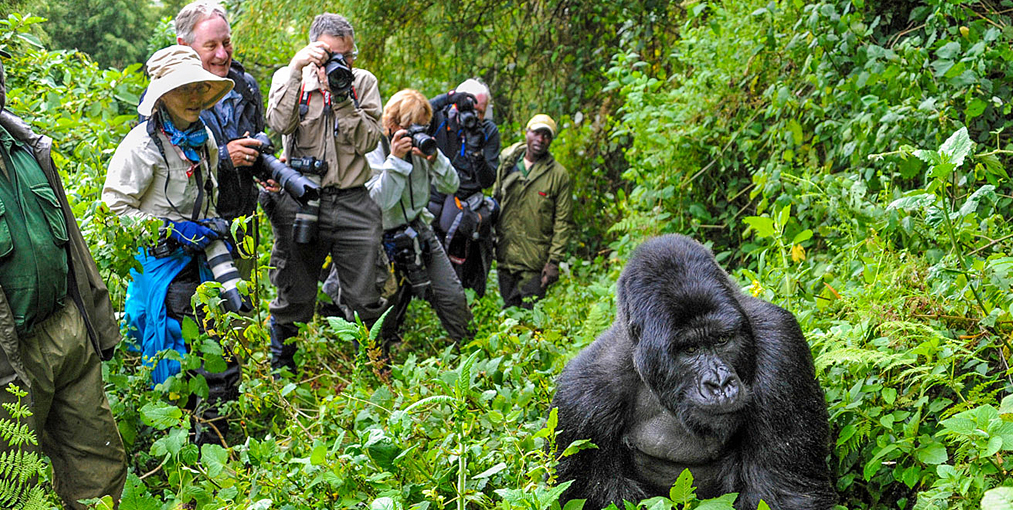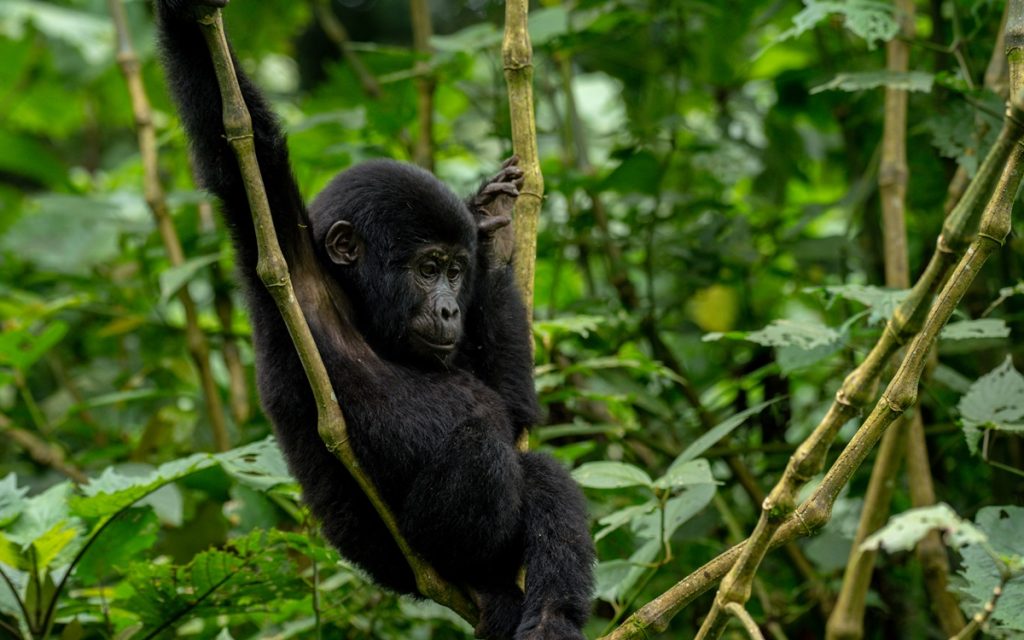- Written by: Friendly Gorillas Editor
- January 4, 2025
Golden Monkey Habituation Experience
Golden Monkey Habituation Experience
The Golden Monkey Habituation Experience provides a unique chance to get up close and personal with wildlife in Uganda’s Mgahinga Gorilla National Park. Mgahinga Gorilla National Park may be home to the greatest number of golden monkeys, an endangered species of monkey found only in East Africa’s Virunga Mountains.
During the full-day Golden Monkey Habituation Experience, guests can spend many hours with a group of habituated golden monkeys. The opportunity to watch the monkeys as they go about their regular lives, feeding, playing, and grooming, will be provided to visitors during the encounter. Experienced tour guides and experts will help impart knowledge to visitors on the behavior and social dynamics of the golden monkeys.

The habituation procedure involves introducing humans one at a time until the monkeys become accustomed to the presence of humans. It may take several years to complete this process, but once it is done, we will be able to study the monkeys in their natural environment and create conservation plans that will benefit them.
The Golden Monkey Habituation Experience provides a unique opportunity to interact closely with these magnificent, much endangered primates and learn more about the substantial conservation efforts that are being made to ensure their safety. The idea that strolling and hiking in the forest will take the entire day should not be overlooked.
People of all ages and fitness levels will enjoy the excursion. The Virunga Volcanoes in East Africa are home to the golden monkey (Cercopithecus mitis kandti), a unique and endangered species of primate. The Virunga Volcanoes are a chain of volcanoes that cross the borders of Uganda, Rwanda, and the Democratic Republic of Congo, and the golden monkeys are found in all three countries.
Male golden monkeys can weigh up to 10 kg, but females can only weigh up to 7 kg. Golden monkeys are a medium-sized primate species. Their unique golden-orange fur, which is long and dense, and their black features set them apart. They navigate the trees using their long tails to help them stay balanced.
The majority of golden monkeys’ lives are spent in the trees of the bamboo woods where they are found. Being gregarious creatures, they can coexist in groups of up to 80 people, though typically there are only about 30 in each. Males and females in the group are arranged in a rigid hierarchy, with dominant members having first dibs on food and partners.
Golden monkeys are omnivores, meaning they eat a variety of plant and animal items, including microscopic insects, leaves, fruits, and bamboo shoots. They are busy throughout the day, spending much of it engaging with other members of the group and hunting.
The golden monkey and its natural habitat are being protected through conservation initiatives.
The Golden Habituation Process
The Alpha male leads the group of Golden Monkeys, which consists of roughly 100 members. Their main sources of food include bamboo shoots, different seasonal fruits, lichens, sprouts, flowers, and tiny invertebrates. They inhabit the same region as gorilla trekkers, the Bamboo Forests, one of the six Afro-Montane zones on the volcanoes.

In order for people to travel and see golden monkeys, they must get acclimated. You will spend roughly three hours with the Golden Monkeys while accompanied by Rangers and researchers.
It takes about six hours in total; the Golden Monkey Habituation Experience is a shorter hike than gorilla trekking. One reason for this could be since they don’t move daily to build new nests, in contrast to giant apes like mountain gorillas and chimpanzees.
Rather than forcing them to flee, golden monkeys are acclimatized to humans by watching them as they go about their daily lives. Enter the Habituation of the Golden Monkey to take part in that process. The extended periods will allow you to take more pictures and observe other primates, birds, and wildlife.
Suggested Safari Itineraries
Golden Monkey Habituation packing list
You must wear the same equipment for the Golden Monkey Habituation Experience as you would for a Gorilla Trek in order to protect yourself from thorns, nettles, ants, and flies. There won’t be any mosquitoes or Tsetse flies at this altitude.
Daypack: If you’re traveling to Uganda, you can utilize a waterproof daypack as a carry-on. Stow the daypack containing all of your necessities.
Hiking Boots: Ensure that your hiking boots have sturdy treads. You will require ankle support, which boots provide, to help you navigate muddy trails. Wear quality merino wool socks.
Long Trouser: They will shield you from nettles and prickles. For further ant protection, tuck the pants into your socks.
Long-Sleeved Shirt: Neutral in color. Again, this is for your comfort and protection.
Rain Jacket or Poncho: Pack into your daypack. You never know when it will train. You are in an Afro-montane Rainforest.
Tough Gardening Gloves: This is to protect your hands from thorns, nettles, and sharp branches.
Wide Brimmed Hat: It gives you protection from the Sun.
Camera Equipment Binoculars: Ensure extra batteries and storage devices. Put them into Ziploc bags. Binoculars are not needed if you are not a birder.
Packed Lunch and Bottled Water: You will need your packed lunch from the lodge and two liters of bottled water.
Insect Repellent Sun Lotion Sunglasses: We recommend the effective Australian RID Insect Repellent. Good Sun blocker cream and sunglasses.
Where to do Golden Monkey Habitation
The Virunga Mountains are a volcanic series that spans Rwanda, Uganda, and the Democratic Republic of Congo. High-altitude bamboo forests in these mountains are home to golden monkeys. These fascinating primates can be found in the Virunga National Park (DRC), Mgahinga Gorilla National Park (Uganda), and Volcanoes National Park (Rwanda).

The only place to experience golden monkey habituation is Mgahinga Gorilla National Park, which is situated in the Kisoro district of southwest Uganda. In addition, golden monkey trekking is available in the national park; this activity is also available in Rwanda’s Volcanoes National Park.
How much is the golden monkey habitat permit?
The permit of a golden monkey habituation costs USD100 and can be booked at Uganda Wildlife Authority head office or on ground in Mgahinga National Park.
Recommended Safaris
4 Days Rwanda Gorilla Tour and Golden Monkey Trekking
$ 2500
per person11 days Uganda Premium Gorilla, Wildlife & River Nile Adventure
$ 2900
per personBest time to do golden monkey habituation experience
The Mgahinga Gorilla National Park offers year-round golden monkey habituated experiences, but the best times to visit are during the dry season, which runs from June to September and December to February. During these months, the park receives less rainfall, which means that the vegetation is thinner and more pliable, making for excellent primate viewing.

How to get there
By Road transport, it takes nine to ten hours to drive from Kampala to the park headquarters, passing through Masaka, Mbarara, Kabale, and Kisoro along the way
By Air: travelers can also arrange scheduled or charter domestic flights with Aero Link Uganda or Bar Aviation from Kajjansi airfield or from Entebbe International Airport to reach Mgahinga Gorilla National Park by air.
In conclusion, the Golden Monkey Habituation offers an opportunity for a deeper connection with nature than just a typical safari. Take part in this amazing adventure with Friendly Gorilla Safaris, where you will get up close and personal with Uganda’s captivating golden monkeys at every turn.
Friendly Gorillas Editor

Ready for your ultimate wildlife experience?
Chat with us, our team is always here to help!
You may also like …

Got any questions
about traveling to Uganda?
Get in touch.








